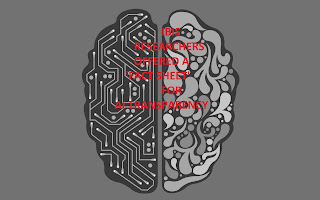About:
IBM Research published a
paper that demands a supplier's announcement to suit the AI services. This
announcement will include information on performance, safety and security.
Paradise life is using AI to increase life insurance policy for those who will
not be traditionally eligible, such as chronic diseases and non-U.S. With the
citizens.
 |
IBIS RESEARCHERS OFFERED A 'FACT SHEET
|
Description:
Google Driving Car Spinoffs
Wemo is tapping to provide mobility to the elderly and people with
disabilities. But despite good AI, it is clearly capable, doubt is dependent on
its security, transparency and bias. In other industries, these documents are
present, and although they are voluntary in many cases, these attempts often
become standard. Energy Star or the U.S. Think of Bond Rating in Consumer
Product Safety Commission or Financial Industry.
AI Research and AI
Foundation's key AI Mozambique today said that AI services should be
"created, tested, trained, deployed and evaluated", there has not
been any compromise, IB Research and AI Science for Social Good Program. blog
post. In theory, these documents will also enable more liquid AI service
markets and bridge information intervals between consumers and suppliers. IBM
Research said that SDOC should be voluntary.
Mojsilovic and colleagues are
formally declared as supporters of the declaration of voluntary facts, which
will be completed and published by those companies who develop and provide AI
with the aim of increasing their transparency and enhancing their services. .
Mojsilovic thinks such factsheets can give competitive advantage to companies
in the market, such as how to get energy equivalent energy products for energy
companies for energy efficiency.
Many core pillars make the
basis for faith in AI systems, Mojsilovic explained: fairness, robustness, and
interpretation. The fair AI system can be reliably trusted that there is no
biased algorithm or dataset, or contributes to inappropriate treatment of some
groups. If an AI system is fair but can not oppose the attack, then it will not
be believed. If it is safe but we can not understand its output, then it will
not be believed. To make AI systems that are really trustworthy, we need to
strengthen all the columns together.
AI services will address such questions
as:
1.) What is the expected
behavior when distracted by data distribution distribution distribution?
2.) Who is the target user of
the explanation?
3.) What was investigated for
dataset and model prejudices?
4.) Use data is maintained /
kept / maintained with service operation?
5.) What was a bias on the
dataset?
6.) Was the service checked
for opposition against the adverse attacks?
7.) Is there a datasheet or
data statement in the dataset used to train the service?
8.) Was the service tested on
any additional datasets? Do they have datasheets or data statements? If so,
describe the test method.
9.) Can the algorithm be
interpreted / interpreted as output? If so, explain why interpretation is
achieved?
10.) Was the service checked
for opposition against the adverse attacks?
11.) What type of governance
is employed to track the overall workflow of AI service data?
Understanding and evaluating
AI systems is a very important issue for the AI community, it is an issue
that we believe industry, academic and AI practitioners should work together.
No comments:
Post a Comment